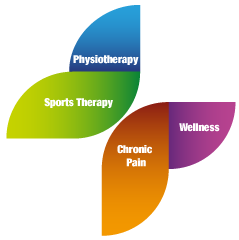Upper Back Pain Relief Treatments
Do you feel pain in the upper and mid-back? Does your spine curve outwards a lot in this area, and then back in a lot below?
If so, you may have Scheuermann’s disease.
This is a ‘hunchbacked’ condition, affecting children normally of teenage years. It is believed to be caused by genetic failings in the blood supply to growing cartilage, and bone cells die off in the spinal vertebrae where they should be growing, leaving a very curved, over thoracic spine. This leads to backache.
Treatment, especially during teens, would be specialised physiotherapy exercises and pain-relieving electrotherapy.
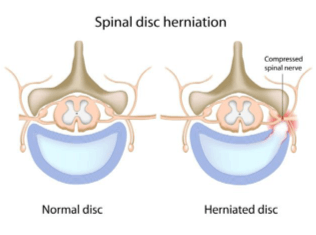 Do you feel pain in your mid-back, that can feel like a band going all around to the front of your chest?
Do you feel pain in your mid-back, that can feel like a band going all around to the front of your chest?
Have you experienced arm or leg weakness or numbness, pins and needles, or bladder/ bowel changes?
THORACIC DISC HERNIATION
Discs can be damaged by trauma or repetitive overloading – such as heavy lifting – and will degenerate with age but get less troublesome. In some conditions the fibrous ring will tear, allowing the soft inner contents to rupture through (herniate). This process is known as ‘disc herniation’ and is most common in the two lowest discs in the lumbar spine.
Disc herniation can cause the compression of the exiting nerves or the nerve root and can result in symptoms such as local pain, pain in the torso and/or limbs, pins and needles, loss of strength, and loss of motor control. In some cases, loss of bladder or bowels can also occur.
Diagnosis is by physiotherapy assessment, MRI, and orthopaedic consultation, and treatment can include: GunnIMS, Acupuncture, and exercise with physiotherapy. Severe cases may need surgery.
KYPHOSIS POSTURAL SCOLIOSIS
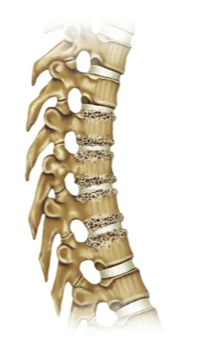 Scoliosis can occur from birth, or it can develop slowly in childhood, with the child often not realising that anything is amiss as often there is no pain. In the majority of cases, children do not need treatment as the condition self corrects, though a brace can help to prevent the condition from worsening.
Scoliosis can occur from birth, or it can develop slowly in childhood, with the child often not realising that anything is amiss as often there is no pain. In the majority of cases, children do not need treatment as the condition self corrects, though a brace can help to prevent the condition from worsening.
For adults, the condition is usually painful, with the pain local to the curvature in the spine and sometimes into the legs, along with numbness and
weakness. Other symptoms can include loss of bladder and bowel control, and treatment is usually conservative, with surgery only considered in severe cases. Scoliosis occurs in around 70% of adults over 65.
Diagnosis is by physiotherapy assessment, X-ray, and orthopaedic opinion, and treatment can include: physiotherapy, mobilisations, Theraflex, Acupuncture, Gunn IMS dry needling, strengthening and stretching, and deep tissue massage. For one-sided sports, at the end of the game, practice using your other arm.
Do you have pain when moving the spine, twisting, and side bending? Does deep breathing or coughing increase that pain?
If so, you may have costovertebral joint ligament sprains.
COSTOVERTEBRAL JOINT LIGAMENT SPRAINS
The costovertebral joints are located in the upper (thoracic) spine and occur where each rib meets the spinal vertebrae on both sides of the spine. Any activity, through trauma, certain movements, or repetitive activity – which overloads the joint – can cause injury to one or more of the costovertebral joints. Pain may be felt immediately, or on the following morning, combined with stiffness. The pain will be felt at the spine, or it may travel around the chest and into the arm, and will be made worse by deep breathing, coughing, sneezing, or by bending and twisting.
In most cases the condition will heal in about six weeks, provided that aggravating activities are avoided and that the physiotherapy regime is followed. Diagnosis is by physiotherapy assessment, and treatment can include: initially RICE then physiotherapy to prescribe mobility exercises, Acupuncture, ultrasound, pulsed shortwave, mobilisations and manipulations, and postural advice. You may also see a sports therapist for some soft tissue therapy.
On a sudden movement, did you feel a tearing in your upper back?
If so, you may have intervertebral ligament sprains.
INTERVERTEBRAL LIGAMENT SPRAINS
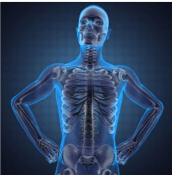 Ligaments are made of strong fibrous material that is positioned to strengthen and stabilise a joint. They are prone to damage when overloaded, due to, say, a trauma
Ligaments are made of strong fibrous material that is positioned to strengthen and stabilise a joint. They are prone to damage when overloaded, due to, say, a trauma
– such as a car accident – or from more everyday activities such as lifting while bending or twisting. Pain will be felt and may be aggravated by deep breathing, coughing, or sneezing. In most cases the ligaments will heal within four weeks, helped by avoiding aggravating activities.
Diagnosis is by physiotherapy assessment, and treatment options include: RICE, sports massage, shockwave, and physiotherapy to prescribe stretching and mobilising exercises.
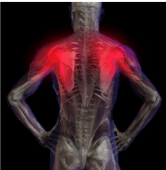 Are your neck muscles and the muscles between your shoulder blades always tight?
Are your neck muscles and the muscles between your shoulder blades always tight?
If so, you may have chronically tight muscle contractures.
CHRONICALLY TIGHT MUSCLE CONTRACTURES
Diagnosis is by physiotherapy/physical therapy assessment, and treatment can include: posture improvement (especially with the heat), stretching routines, regular sports massage, and strengthening exercises. If persistent or non-resolving, try Gunn IMS and shockwave therapy.
Have you ever had pain suddenly occur in your back with movement, for example, when bending to tie up your laces? Is the pain localised to one spot in your back and does it not radiate out anywhere?
If so, you may have mechanical back pain.
MECHANICAL BACK PAIN
Mechanical back pain is a general category that includes pain from the spinal vertebrae, joints, or soft tissues, but the source of the pain is ill-defined as usually there are no definable causes found from physical examinations or MRI scans. It can occur due to poor posture, lack of exercise, or just aging. Pain does not travel down the limbs – it remains localised – and treatment can include: manipulation, posture and exercise advice, massage, and Acupuncture.
FACET JOINT BLOCK
(Please see description in the neck section). This responds well to specific manipulations, and if straight forward, can be adjusted in just one session – the clunk is very satisfying.
DISC BULGE
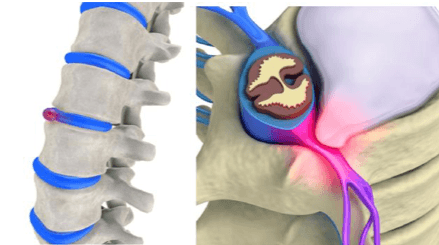
Also referred to as a slipped disc or prolapsed disc, this is when the soft disc cushion between the spinal vertebrae suffers constant loading from daily activity. Often such activities will overload the disc and cause a bulge in the side, but without the fibrous ring rupturing (becoming herniated). This is much like the bulge in a car tyre, caused by hitting a curb.
DISC PROLAPSE
A disc may bulge into the central spinal column or sideways into the exiting nerves and can, if excessive, create compression on the nerves, sufficient enough to cause local or distal pain in the limbs, numbness and weakness, and loss of motor function.
Diagnosis is by physiotherapy assessment, X-ray, and MRI, and treatment can include: Gunn IMS, electro-acupuncture, laser, and core stability rehab and exercises. If severe, surgery may be needed.
